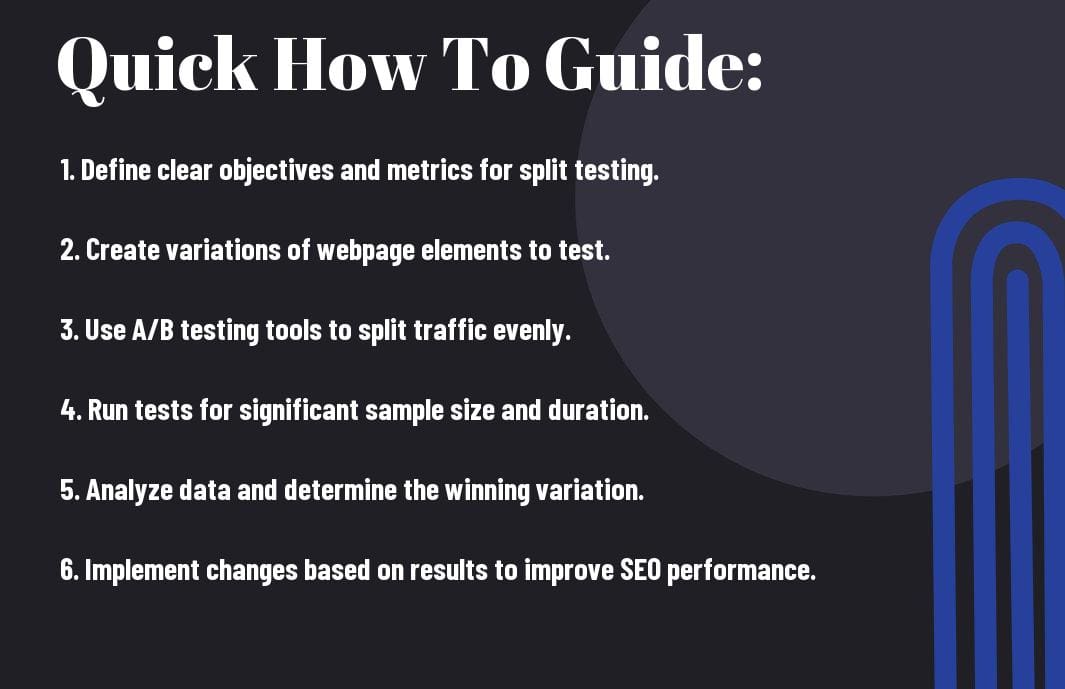Overwhelmed by the vast sea of data and uncertainties in the world of SEO? Learn how to navigate through the noise and drive your website to success with SEO split testing. This powerful technique allows you to compare different versions of your web pages to determine which one performs best in search engine results. Understanding how to conduct split testing effectively can make a significant impact on your online visibility and traffic. In this blog post, we will provide you with pro tips on how to execute SEO split testing for maximum results. Stay tuned to unlock the secrets of optimizing your website for peak performance in search engine rankings.
Key Takeaways:
- Conducting SEO Split Testing: Split testing is a crucial method to determine the effectiveness of SEO strategies by comparing different versions of web pages.
- Use a Reliable Testing Tool: To ensure accurate results, it is crucial to use a trusted and robust testing tool that can provide detailed insights and data.
- Focus on Key Metrics: When analyzing the results of SEO split testing, pay close attention to key metrics such as organic traffic, bounce rate, click-through rate, and conversions to make informed decisions for optimization.

Preparing for SEO Split Testing
Identifying Key Performance Indicators (KPIs)
Clearly, before submerging into SEO split testing, it is crucial to identify the Key Performance Indicators (KPIs) that will help gauge the success of your experiments. These can include metrics such as organic traffic, click-through rates, keyword rankings, and conversion rates. By setting clear KPIs, you can track the impact of your changes accurately.
Selection of SEO Factors for Testing
Clearly, when selecting SEO factors for testing, it’s important to focus on elements that can have a significant impact on your website’s performance. Consider testing variables such as meta titles, meta descriptions, heading tags, and content length. Any changes made should be based on data-driven insights to ensure meaningful results.
- Meta titles
- Meta descriptions
- Heading tags
- Content length
Indicators suggest that the selection of the right SEO factors is crucial for successful split testing. By focusing on impactful elements and making data-driven decisions, you can effectively optimize your website for better results. Any changes implemented should be carefully monitored and analyzed for their impact on key metrics.
Creating a Controlled Testing Environment
For a successful SEO split testing process, creating a controlled testing environment is imperative. This involves setting up separate test groups, ensuring that only one variable is changed at a time, and running tests for a long enough duration to gather sufficient data. Selection of a controlled environment will help in accurately attributing any changes in performance to the specific variables being tested.
Executing SEO Split Testing
Designing Effective Split Tests
For SEO split testing to be effective, it is crucial to carefully design the experiments. Identify the specific elements you want to test, such as meta descriptions, title tags, or page content. Ensure that your test groups are large enough to yield statistically significant results and randomize the allocation of visitors to each group. Testing variations should be distinct and focus on one element at a time to accurately measure the impact.
Implementing Tests and Monitoring Performance
Tests should be implemented using reliable tools that can accurately track performance metrics. Regular monitoring is necessary to analyze the data, identify trends, and make informed decisions based on the results. Implement changes based on the winning variations and continue to iterate to improve SEO performance over time.
In addition to monitoring traffic and conversion rates, it is important to consider other factors such as bounce rates, time on site, and engagement metrics. Adjust the duration of tests based on the level of traffic to ensure statistical significance and don’t forget to apply the learnings from each test to future experiments.

Analysing and Interpreting Results
Tools for Measuring Split Test Outcomes
Many digital marketing tools offer features specifically designed for measuring the outcomes of split tests. These tools provide in-depth analytics and insights into how different versions of your website or content are performing. It is crucial to use these tools to track key metrics and understand which variations are yielding the best results.
Learning from Your Split Testing Data
Measuring the impact of your split tests is only the first step. The real value lies in interpreting the data to make informed decisions for your SEO strategy. By analyzing the results, you can uncover valuable insights about your audience preferences and behavior. This information can help you optimize your website for better performance and higher conversions.
The key is to pay close attention to patterns and trends in the data. Look for significant differences in metrics such as click-through rates, bounce rates, and conversion rates. Your goal should be to identify which elements of your content or website are resonating with your audience, and which ones are falling short.
Expert Tips for Maximized Outcomes
Keep your SEO split testing strategy on track with expert tips that can help you achieve maximum results. By following these recommendations, you can ensure that your testing efforts yield valuable insights and drive improved SEO performance.
Iterative Testing and Continuous Improvement
You can achieve significant results by continuously testing and refining your SEO strategies. Through iterative testing, you can make incremental changes to your SEO elements and monitor their impact on search engine rankings and user engagement. It’s vital to maintain a disciplined approach to testing and embrace a mindset of continuous improvement to achieve sustained success in SEO split testing.
Avoiding Common Split Testing Pitfalls
There’s a fine line between successful SEO split testing and wasted efforts. Common pitfalls such as insufficient sample sizes, inconclusive results, and improper test implementation can hinder the effectiveness of your testing efforts. It’s crucial to be aware of these pitfalls and take proactive measures to avoid them when conducting SEO split tests.
Avoiding these pitfalls can save you time and resources while maximizing the impact of your SEO split testing. By ensuring that your tests are properly set up, adequately powered, and accurately analyzed, you can make informed decisions that drive SEO performance improvements. Knowing how to navigate these challenges can lead to more insightful test results and better SEO outcomes.
Summing up
Following this comprehensive guide on conducting SEO split testing will help you achieve maximum results for your website. By carefully planning your strategy, implementing the right tools, and analyzing the data accurately, you can make informed decisions that will drive more traffic and improve your search engine rankings. Remember that SEO is an ongoing process, so continue to test and iterate to stay ahead of the competition and keep your website optimized for success.
FAQ
Q: What is SEO split testing?
A: SEO split testing, also known as A/B testing, is a technique used to compare two versions of a web page or element to determine which one performs better in terms of search engine optimization (SEO) metrics. By conducting split tests, you can identify the most effective strategies for improving your website’s visibility and rankings on search engines.
Q: Why is SEO split testing important for maximum results?
A: SEO split testing is crucial for achieving maximum results because it allows you to make data-driven decisions based on actual user behavior. By testing different variables such as meta titles, meta descriptions, header tags, and content variations, you can optimize your website for higher click-through rates, improved engagement, and ultimately, better SEO performance.
How can I conduct SEO split testing for maximum results?
A: To conduct SEO split testing for maximum results, follow these steps:
1. Identify the elements you want to test, such as titles, meta descriptions, or images.
2. Create variations for each element to test different strategies.
3. Use an A/B testing tool or platform to split traffic between the variations.
4. Monitor the performance metrics, such as click-through rates and conversions.
5. Analyze the results and implement the changes that lead to the best SEO outcomes.




